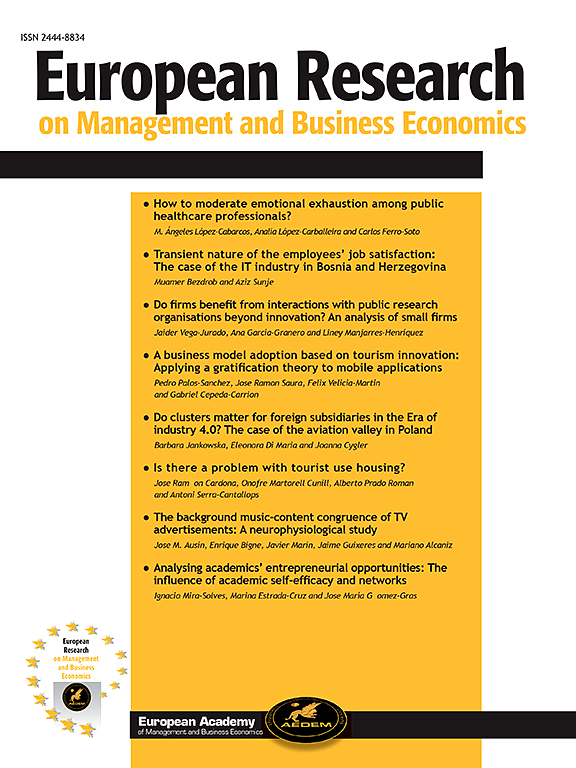eWOM and content marketing strategies: maximizing brand engagement among social media users in Spain
IF 6.4
3区 管理学
Q1 BUSINESS
European Research on Management and Business Economics
Pub Date : 2025-08-28
DOI:10.1016/j.iedeen.2025.100293
引用次数: 0
Abstract
This study analyses how brands' content marketing strategies on social networks influence electronic word of mouth (eWOM), a major predictor of business success that reflects consumer engagement and shapes behaviours such as increased purchase intention, willingness to pay more, reduced perceived risk, and strengthened brand trust and loyalty. While prior research has focused on isolated aspects of digital communication, such as message format or content appeal, this work incorporates additional key elements—brand humanization, personalization, and conversational relationships—that are essential for fostering trust and engagement in today's audiovisual content on platforms like Instagram and TikTok.
Grounded in theories such as Service-Dominant Logic, brand personalization and humanization, Uses and Gratifications, trust transfer, Marketing Communications Theory, and Media Richness Theory, this research proposes a conceptual model based on the stimulus-organism-response (SOR) framework. The study analyses 250 Instagram posts and 250 TikTok posts from top-interaction consumer brands in Spain, measuring independent variables such as brand consistency, post position, message format, celebrity endorsement, content attractiveness, and interactivity, with eWOM operationalised as the volume of likes and comments. Control variables included posting day, emoji use, and post length, with content analysis applied for coding and negative binomial regression for hypothesis testing.
Findings reveal platform-specific patterns: while message format drives eWOM on TikTok, content attractiveness is more influential on Instagram. Celebrity endorsement is the only variable showing similar effects across platforms, increasing likes on both networks and comments on TikTok. This work addresses the gap in comparative analyses of content effectiveness between platforms with distinct social and technical dynamics, offering evidence-based insights for optimising brand communication strategies according to platform-specific audience interaction styles, message temporality, and visual engagement.
edom与内容营销策略:最大化西班牙社交媒体用户的品牌参与度
该研究分析了品牌在社交网络上的内容营销策略如何影响电子口碑(e口碑),e口碑是商业成功的主要预测因素,反映了消费者的参与和塑造行为,如增加购买意愿,愿意支付更多,降低感知风险,加强品牌信任和忠诚度。虽然之前的研究主要集中在数字通信的孤立方面,如消息格式或内容吸引力,但这项工作结合了其他关键因素——品牌人性化、个性化和对话关系——这些因素对于在Instagram和TikTok等平台上培养信任和参与今天的视听内容至关重要。本研究在服务主导逻辑、品牌个性化与人性化、使用与满足、信任转移、营销传播理论、媒体丰富度理论等理论基础上,提出了基于刺激-有机体-反应(SOR)框架的概念模型。该研究分析了西班牙顶级互动消费品牌的250个Instagram帖子和250个TikTok帖子,测量了品牌一致性、帖子位置、消息格式、名人代言、内容吸引力和交互性等独立变量,并将eom作为点赞和评论的数量进行操作。控制变量包括发布日期、表情符号使用情况和帖子长度,采用内容分析进行编码,负二项回归进行假设检验。研究结果揭示了平台特定的模式:虽然消息格式驱动TikTok上的eom,但内容吸引力对Instagram的影响更大。名人代言是唯一一个在不同平台上表现出类似效果的变量,无论是在网络上还是在TikTok上都增加了点赞。这项工作解决了具有不同社会和技术动态的平台之间内容有效性比较分析的差距,根据平台特定的受众互动风格、信息时间性和视觉参与,为优化品牌传播策略提供了基于证据的见解。
本文章由计算机程序翻译,如有差异,请以英文原文为准。
求助全文
约1分钟内获得全文
求助全文
来源期刊
CiteScore
11.70
自引率
3.40%
发文量
30
审稿时长
50 weeks
期刊介绍:
European Research on Management and Business Economics (ERMBE) was born in 1995 as Investigaciones Europeas de Dirección y Economía de la Empresa (IEDEE). The journal is published by the European Academy of Management and Business Economics (AEDEM) under this new title since 2016, it was indexed in SCOPUS in 2012 and in Thomson Reuters Emerging Sources Citation Index in 2015. From the beginning, the aim of the Journal is to foster academic research by publishing original research articles that meet the highest analytical standards, and provide new insights that contribute and spread the business management knowledge

 求助内容:
求助内容: 应助结果提醒方式:
应助结果提醒方式:


